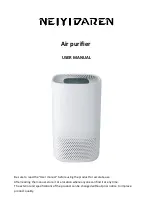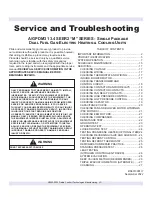
Page 20
505095M 1/3/06
When removing debris from around the unit, be aware
of metal edges on parts and screws. Although special
care has been taken to keep exposed edges to a
minimum, physical contact with metal edges and cor-
ners while applying excessive force or rapid motion
can result in personal injury.
Cleaning of the outdoor unit’s coil should be performed
by a trained service technician. Contact your dealer
and set up a schedule (preferably twice a year, but at
least once a year) to inspect and service your air con-
ditioning or heat pump system.
Thermostat Operation
Thermostat operations vary from one thermostat to anoth-
er. The following provides general operation procedures.
Refer to the user’s information manual provided with your
thermostat for specific operation details.
Temperature Setting Levers
Set the lever or dial to the desired temperature setpoints
for both heating and cooling. Avoid frequent temperature
adjustment; turning the unit offthen back onbefore
pressures can equalize will put unusual stress on the unit’s
compressor.
Fan Switch
In AUTO or INT (intermittent) mode, the blower operates
only when the thermostat calls for heating or cooling. This
mode is generally preferred when humidity control is a
priority. The ON or CONT mode provides continuous in-
door blower operation, regardless of whether the com-
pressor or furnace is operating. This mode is required
when constant air circulation or filtering is desired.
System Switch
Set the system switch for heating, cooling or auto opera-
tion. The auto mode allows the system to automatically
switch from heating mode to cooling mode to maintain
predetermined comfort settings.
Temperature Indicator
The temperature indicator displays the actual room
temperature.
Programmable Thermostats
Your Lennox system may be controlled by a
programmable thermostat. These thermostats provide the
added feature of programmable time-of-day setpoints for
both heating and cooling. Refer to the user’s information
manual provided with your thermostat for detailed pro-
gramming and operation details.
Preservice Check
If your system fails to operate, check the following before
calling for service:
S
Check to see that all electrical disconnect switches are
ON.
S
Make sure the room thermostat Temperature Selector
and System Switch (Heat, Cool, Auto) are properly
set.
S
Check for any blown fuses or tripped circuit breakers.
S
Make sure unit access panels are in place.
S
Make sure air filter is clean.
S
If service is needed, locate and write down the unit
model number and have it handy before calling.
Sound Reduction Cover (SR1) Components and Assembly Procedure
This diagram identifies the sound reduction
components and shows the correct procedure for
assembling the sound reduction cover:
1. Put SR1 base on unit base pan.
2. Install compressor on base.
3. Cover SR1 base with wet rags to protect against
any brazing material.
4. Braze suction tube.
5. Braze discharge tube.
6. Cool connections to ambient temperature.
7. Perform leak check.
8. Install suction grommet.
9. Install SR1 left and right side covers.
10. Fasten 60" bottom cable tie.
11. Install discharge grommet.
12. Install top caps.
13. Fasten 36" top cable tie.
14. Fasten 36" middle cable tie.
Figure 19
MIDDLE CABLE TIE
BASE
BOTTOM CABLE TIE
SUCTION
GROMMET
LEFT
SIDE
COVER
RIGHT
SIDE
COVER
DISCHARGE
GROMMET
LEFT
TOP
CAP
RIGHT TOP
CAP
TOP CABLE TIE

































